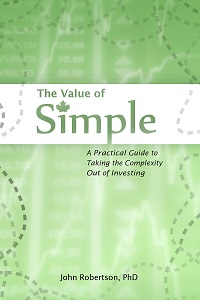Over on the twitter, people wondered whether to contribute to an RRSP if they have a defined benefit pension plan. The answer depends on a few factors, chief amongst them your expected tax rate in retirement versus your tax rate now (or in the near future if you choose to contribute now but defer the deduction for a while). Other factors can include your situation and plans — if there’s a decent chance you’ll need the money before retirement, it may be best to keep it in a non-registered account until you’re sure you can lock it up.
The short answer is easy though: most of the time an RRSP is better than investing in a non-registered account, even if you have a DB pension. You can think of it like this: you have a pension adjustment if you’re in a DB plan, so you likely only have a bit of RRSP room, with the rest being used by your pension. If you had no pension and lots of room, would you use all of it or only 80%? Maybe you’d be in a case where only using a bit made sense, but likely you’d use it all if you could.
Really the only clear case where you should not use your RRSP is if you expect to be on GIS in your old age (but in that case it’s not likely that you have a job that’s offering a DB pension).
The easy case is when your tax rate in your earning (and saving) years is higher or equal to your tax rate in retirement: the RRSP will make sense (assuming you invest the refund or would invest less if you were using a non-registered account). Indeed, if you do invest the refund the RRSP will beat out the TFSA in terms of returns for the case where your tax rate in your savings years is higher than in retirement.
The harder case is to construct a scenario where your tax rate in retirement is higher in retirement than in your working years. If you’re particularly high in the income spectrum then you could have OAS clawbacks, effectively a 15% surtax on retirement incomes over $71k — which if you’re using a typical DB replacement of 70% means you’d be making over $100k in your working years (over $115k in DB income — say $165k in your working years — and it won’t matter anyway). The most likely case for higher tax rates in retirement is the least predictable one: where your inflation-adjusted income stays the same, but the government of the future has raised tax rates. It’s an analysis paralysis black hole to try to worry about deviations too far from the present set of rules. You could be higher than you are today if you make a lot more later in your career, but then if you expect to move up a tax bracket or two you can still contribute to your RRSP and defer taking the deduction. Still, the answer is not as simple as “skip the RRSP if your tax rate in retirement is higher.”
Even if your tax rate will be higher later, the RRSP can still beat out a non-registered account by allowing for tax-free compounding and easing the record-keeping and reporting burden of investing. The tax-free compounding benefit doesn’t sound that spectacular, but bear in mind that after the first jump the marginal tax brackets in Canada increase fairly shallowly. For instance in Ontario the difference between earning $75k and $90k is only 6%, and that’s made up of a federal 4% jump and provincial 2% increase at similar but not quite identical break points, so you could be “higher” later but have an even smaller difference of maybe just 2%. Would tax-free compounding be worth that?
It’s tough to say because the drag from taxes is not precise, and you can defer some capital gains into retirement, but let’s estimate it: assume you have an 8% nominal return (note that taxes are on nominal returns rather than real returns). Assume that your employment marginal tax rate is 31%, and that through the magic of capital gains partial inclusion, the dividend tax credit, and handwaving, your tax burden on those gains is 12% per year (taking a rate below the half-way mark to try to assume some benefit of capital gains deferral). Then you could invest $10,000 after tax in a non-registered account, earn 8% nominally, and pay $96 in tax the first year, or put the $14,493 pre-tax* into an RRSP, and earn 8% tax-free. After 10 years you’d have $19,745 in your non-registered account versus $31,289 in your RRSP. The tax drag would mean that your tax rate could be as high as 37% after 10 years — 6% higher than our starting tax rate or a full federal + Ontario tax bracket move — and the RRSP would still roughly break even. As time wears on so does the non-registered tax drag — after 28 years in this example the tax-free compounding benefit would offset being hit with OAS clawbacks.
I’m not sure what the correct estimate of the non-registered tax drag would be, but in this example I’m neglecting any tax on deferred capital gains which would further improve the outcome for the RRSP case. I’d ballpark it as somewhere between 1/4 and 1/2 of your marginal tax rate, and likely closer to the high end of that.
So yes, there is a very good chance that investing in an RRSP will beat out investing in a non-registered account, even if you move up by a tax bracket over time or face OAS clawbacks.
Basically:
- If you’re really low income, where you expect to get GIS in retirement, then avoid your RRSP. Invest in a TFSA, and if you manage to have more to invest than your TFSA contribution room, invest in a non-registered account.
- If you’ll be in the same or a lower tax bracket in retirement, then definitely maximize your RRSP! Tax arbitrage FTW! Just remember to invest the refund too, where you can.
-
If you’ll be in a higher tax bracket then it may still be worth it:
-
If you’ll be just one bracket higher, it will quite likely work out better with an RRSP due to the non-registered tax drag.
- If you’re in the OAS clawback range (expected retirement income of ~$71k-$115k in today’s dollars) then consider it carefully, but enough time and non-registered tax drag may still make it worthwhile.
I’ll finish by noting that my rule-of-thumb is simply “TFSA first”. For many the RRSP will come out mathematically optimal (note that the TFSA gets the same benefit of tax-free compounding discussed here), as many people can expect to end up in a lower average tax bracket in retirement. However, the TFSA is more flexible, better for lower-earning people, and moreover is easier to plan around with set contribution limits by year and no pension adjustments, and higher income people can usually find the funds to contribute to both. Mostly though it’s the gap between theory and practice that makes me push the TFSA: most people do not put pre-tax money in their RRSPs (or invest the refunds) — they invest what they have on hand at the time they decide it’s investing day, and then if a refund comes in they spend it. Plus if you figure out later on that an RRSP is better for you, you can easily withdraw from your TFSA and start catching up on your RRSP — if you don’t know any better, the TFSA is a great place to start. Once your TFSA is full, moving on to RRSP next (over non-registered makes sense)**.
Finally, a good related post at Michael James on Money that I couldn’t find a place to link to above.
* – remember that the 31% tax rate is on the pre-tax amount, so the RRSP will have more than $13,100 to invest, but this may come as $13,100 in the first year, then a refund on contributing the refund in a following year, repeating. Or you could fill out the paperwork to get pre-tax money into your RRSP by avoiding tax deductions in the first place.
** – which doesn’t mention the RESP. That depends on your priorities and view towards paying for your kids, but free CESG money is hard to beat so it often goes even ahead of the TFSA.


 Questrade: use QPass 356624159378948
Questrade: use QPass 356624159378948 Passiv is a tool that can connect to your Questrade account and make it easier to track and rebalance your portfolio, including the ability to make one-click trades.
Passiv is a tool that can connect to your Questrade account and make it easier to track and rebalance your portfolio, including the ability to make one-click trades.